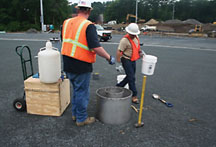
Synthetic Turf Permeability
The synthetic turf industry has been plagued with drainage performance issues for many years. Huge demand has driven the industry to grow and, as more systems have been built, the potential for issues grows. With pricing competition and inexperience being factors, how well a field system drains needs to be addressed in a consistent manner. This challenge has now been addressed with the development of a new standard by ASTM International Committee F08 on Sports Equipment and Facilities.
The new standard, F2898, Test Method for Permeability of Synthetic Turf Sports Field Base Stone and Surface System by Non-Confined Area Flood, is under the jurisdiction of Subcommittee F08.65 on Artificial Turf Surfaces and Systems.
According to John Amato, JJA Sports LLC and an F08 member, synthetic turf system and base system permeability test methods that existed prior to the development of F2898 were not ideal. Some methods required sealing the test apparatus onto the surface, which was impossible to accomplish, or driving steel rings into a base stone, thus disturbing and decompacting in-situ material. Most tests required the development of a hydraulic head over the surface, creating a condition that should never exist in nature. Almost all test methods used were based on small water volumes and did not adequately condition the surface prior to the actual test. None were consistent and all were subject to user technique and assumption errors.
"F2898 is intended to be a simple method, requiring no special testing apparatus, that would decrease the potential for user technique and assumption errors while at the same time providing intuitive and observable results," says Amato. "The method uses a predetermined flow rate from a water source, two simple ball valves, sections of hose, a five-gallon container of measured volume, stopwatch, markers to mark the extent of water migration on the surface and a tape measure. Water source flow rate is calculated using the time it takes to fill the five-gallon container of measured volume as the basis of flow for each individual test."
Amato says that F2898 will replace nonstandardized methods used by turf installers and stone base contractors to estimate the performance of their products and systems. Design engineers can use the method to test their designs and better associate stone type and installation conditions with actual performance. Testing agencies will be able to assess drainage performance of these systems for owners. The method is simple enough that owners, installers, engineers and testing agencies can all perform the test.
To purchase ASTM standards, visit www.astm.org and search by the standard designation number, or contact ASTM Customer Relations (phone: 610-832-9585).
CONTACT Technical Information: John J. Amato, JJA Sports LLC • Westford, Mass. • Phone: 978-692-0247 • Email: jjasports@comcast.net O ASTM Staff: Christine Sierk • Phone: 610-832-9728 • Email: csierk@astm.org O Upcoming Meeting: Nov. 16-18, November Committee Week, Tampa, Fla.
 SN Home
SN Home Archive
Archive Advertisers
Advertisers Masthead
Masthead RateCard
RateCard Subscribe
Subscribe Email Editor
Email Editor